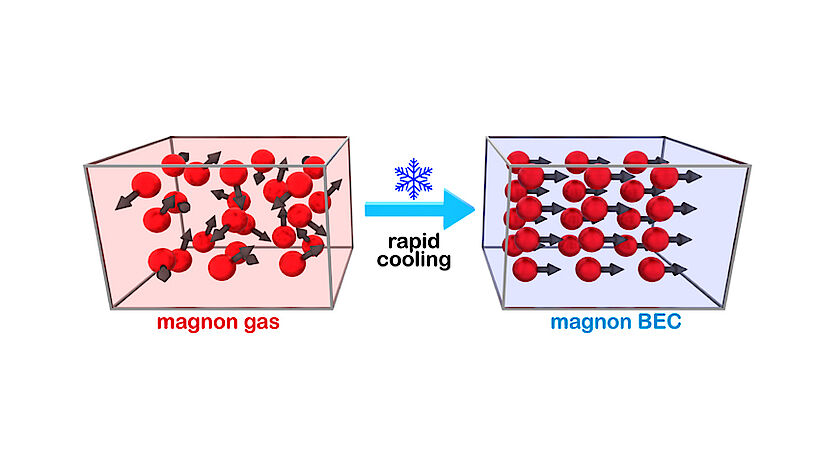Apr 22 2020
Magnon particles that cool quickly offer an unexpectedly effective way to produce Bose-Einstein condensate, which happens to be an enigmatic quantum state of matter.
 (From left to right) Magnon gas particles bounce around in many directions inside a magnetic nanostructure. When rapidly cooled, they all spontaneously jump into the same state, forming a Bose-Einstein condensate (BEC). This is a much simpler method to generate the condensate, which could have implications for quantum computing. Image Credit: Dr Andrii Chumak, Technische Universität Kaiserslautern/Universität Wien.
(From left to right) Magnon gas particles bounce around in many directions inside a magnetic nanostructure. When rapidly cooled, they all spontaneously jump into the same state, forming a Bose-Einstein condensate (BEC). This is a much simpler method to generate the condensate, which could have implications for quantum computing. Image Credit: Dr Andrii Chumak, Technische Universität Kaiserslautern/Universität Wien.
This finding can help to advance the studies relating to quantum physics and bring researchers closer to the long-term objective of room-temperature quantum computing.
Now, an international group of researchers has discovered an easy method to activate a unique state of matter known as a Bose-Einstein condensate. The latest technique, recently explained in the Nature Nanotechnology journal, is anticipated to help improve the research and development of room-temperature quantum computing.
The researchers, headed by physicists from the University of Vienna in Austria and the Technische Universität Kaiserslautern (TUK) in Germany, created the Bose-Einstein condensate (BEC) via a rapid temperature change: initially, the quasi-particles are heated up gradually and then cooled down quickly to the original room temperature.
To demonstrate this technique, the researchers used quasi-particles known as magnons that denote the quanta of a solid body’s magnetic excitations.
“Many researchers study different types of Bose-Einstein condensates,” stated Professor Burkard Hillebrands from TUK and one of the top scientists in the BEC field. “The new approach we developed should work for all systems.”
Puzzling and Spontaneous
Bose-Einstein condensates, which were named after Albert Einstein and Satyendra Nath Bose, who initially suggested their existence, are an unusual type of matter. All these particles behave spontaneously in the same manner on the quantum level, fundamentally assuming a single entity.
Bose-Einstein condensates were initially utilized to explain the perfect gas particles and have been established with atoms and also with quasi-particles like magnons, phonons, and bosons.
It is quite difficult to produce Bose-Einstein condensates because, by definition, they need to take place suddenly. To create the right conditions to generate the Bose-Einstein condensates, no attempts should be made to introduce any kind of coherence or order to support the particles to act in the same manner; this means, the particles have to do that on their own.
At present, Bose-Einstein condensates are produced by administering a vast number of particles at room temperature into a limited space, or by reducing the temperature to an almost absolute zero. But the room temperature approach, initially reported by Hillebrands and colleagues in 2005, is technically complicated and only a minimal number of research groups across the world have gained the required expertise and equipment.
On the contrary, the latest technique is relatively simpler. It needs a minute magnetic nanostructure, which measures 100 times smaller than the width of a human hair, and a heating source.
Our recent progress in the miniaturization of magnonic structures to nanoscopic scale allowed us to address BEC from completely different perspective.
Andrii Chumak, Professor, University of Vienna
The nanostructure is gradually heated up to a temperature of 200 °C to produce phonons, which, consequently, produce magnons that have the same temperature. When the heating source is switched off, the nanostructure cools down quickly to room temperature, in nearly 1 ns. During this process, the phonons travel to the substrate, but the magnons react very slowly and continue to remain within the magnetic nanostructure.
Michael Schneider, the study’s lead paper author and a PhD student in Magnetism Research Group at TUK, elucidated why this occurs: “When the phonons escape, the magnons want to reduce energy to stay in equilibrium. Since they cannot decrease the number of particles, they have to decrease energy in some other way. So, they all jump down to the same low energy level.”
The magnons create a Bose-Einstein condensate by unexpectedly occupying the same level of energy.
We never introduced coherence in the system, so this is a very pure and clear way to create Bose-Einstein condensates.
Andrii Chumak, Professor, University of Vienna
Unexpected Result
As is usually the norm in the science field, the researchers made this finding quite by chance. They had actually embarked to examine a different aspect of nanocircuits, when unusual things started to occur.
“At first we thought something was really wrong with our experiment or data analysis,” added Schneider.
After conferring the work with colleagues at TUK and in the United States, the researchers tuned a few experimental parameters to observe if the unusual thing was indeed a Bose-Einstein condensate. They validated its presence using spectroscopy methods.
The discovery will predominantly interest other physicists investigating this state of matter.
But revealing information about magnons and their behavior in a form of macroscopic quantum state at room temperature could have bearing on the quest to develop computers using magnons as data carriers.
Burkard Hillebrands, Professor, Technische Universität Kaiserslautern
Chumak emphasized the significance of the association within TUK’s OPTIMAS Research Group towards finding a solution to this mystery. For Chumak, it was important to integrate his team’s know-how in magnonic nanostructures with Hillebrand’s knowledge in magnon Bose-Einstein condensates. Two European Research Council (ERC) financial grants provided significant support to the researchers’ project.